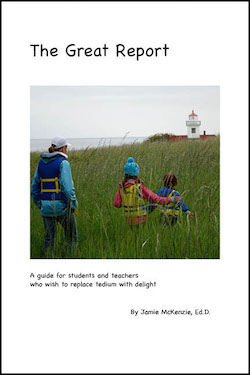What went wrong?
By Jamie McKenzie (about author)
When microcomputers first arrived in American schools during the late 1970s and early 1980s -- some forty years ago -- some of us thought they might revolutionize the way students thought and wrote. We predicted great improvements. Sadly, the NAEP tests of student writing abilities since that time have shown little, if any progress.
How could this be?
Accordion Writing
In 1984 (a year of great importance given Orwell's book with that title) the NCTE published an article of mine in the English Journal -- "Accordion Writing." English Journal, Vol. 73, No. 5, September 1984 http://www.ncte.org/journals/ej/issues/v73-5 (You must be a NCTE member and subscriber to read this article).
The article suggested that word processing could support a different, nonlinear type of composing, thanks to the flexible nature of electronic text. The writer could move back and forth across topics in an outline, expanding, then collapsing items as the mind was ready to address them. Thus the title -- "Accordion Writing."
The Bay Area Writing Project (still in existence today) was having an important impact on the teaching of writing, and computers seemed to be great partners to support this approach.
Unfortunately, in many schools, the computer was not used until the final draft, so these advantages went unexplored and the main benefit was a neater final copy.
To realize the benefits possible when computers would be used for writing, teachers would need two things that were sadly lacking in most districts:
Extended professional development showing them how computers might support the "writing as process" advocated by the Bay Area Writing Project. Opportunities to practice this kind of writing themselves. A week long summer workshop of 25-40 hours would be a solid first step.
 © iStock.com © iStock.com
Disappointing NAEP Results
For many years the National Assessment of Educational Progress (NAEP) has reported the percentage of American students performing at the advanced level, the proficient level, the basic level and below. The 2011 NAEP Writing Report Card for grades 8 and 12 showed the following:
24 percent of students at both grade levels scored at the proficient level on the writing assessment, while 54 percent of eighth graders and 52 percent of 12th graders met the benchmark for basic. Around 20 percent of both grades performed below basic, while only 3 percent scored at the advanced level.
Back in 2007, the results were quite similar. Farther back in 1998, the percentage of students reaching proficient was 27 for 8th Grade and 22 for 12th Grade. Only 1 percent reached advanced at both grades in that year.
Can we be satisfied with these results?
Did a large enough percentage of students reach proficient?
Are we content with “proficient?”
Can we afford to ignore “advanced?”
Achievement level definitions
Basic |
This level denotes partial mastery of prerequisite knowledge and skills that are fundamental for proficient work at each grade. |
Proficient |
This level represents solid academic performance for each grade assessed. Students reaching this level have demonstrated competency over challenging subject matter, including subject- matter knowledge, application of such knowledge to real-world situations, and analytical skills appropriate to the subject matter. |
Advanced |
This level signifies superior performance. |
On the surface, “proficient” as defined by the thesaurus may sound quite impressive as words such as skilled, skillful, expert, experienced, accomplished, competent, and adroit are associated with the term.
A deeper reading of the expectations stated in the 1998 Writing Report Card makes it clear that those words are too lofty for the term “proficient” as defined in that document. They are better suited for “advanced.”
Writing achievement levels, grade 8
Basic |
Eighth-grade students performing at the Basic level should be able to produce an effective response within the time allowed that shows a general understanding of the writing task they have been assigned. Their writing should show that these students are aware of the audience they are expected to address, and it should include supporting details in an organized way. |
Proficient |
Eighth-grade students performing at the Proficient level should be able to produce a detailed and organized response within the time allowed that shows an understanding of both the writing task they have been assigned and the audience they are expected to address. Their writing should include precise language and varied sentence structure, and it may show analytical, evaluative, or creative thinking. |
Advanced |
Eighth-grade students performing at the Advanced level should be able to produce a fully developed response within the time allowed that shows a clear understanding of both the writing task they have been assigned and the audience they are expected to address. Their writing should show some analytical, evaluative, or creative thinking and may make use of literary strategies to clarify a point.
At the same time, the writing should be clearly organized, demonstrating precise word choice and varied sentence structure. |
We really must do better. We should be seeing 60-70 per cent of our American students reaching the proficient level or better. We should be seeing 15-30 per cent performing at the advanced level.

Toolishness is closely associated with other terms such as Foolishness, PowerPointlessness, MicroSoftness, Mentalsoftness™, Disneyfication, Edutainment and Infotainment.
| Laptops do not write well!
Unfortunately, in many school districts, the purchase of equipment dominated the change process, as if laptopping students would create a generation of good writers and smart thinkers.
These districts bought into the notion that "one on one" laptopping would work educational miracles. It did not. And they invested very little in the professional development or planning that would have taken full advantage of the new equipment to improve teacher and student performance.
Fifteen years ago, I wrote an article -- "The Post-Installation Action Plan" -- that described how to address this phenomenon after I visited a district in Illinois that was busily filling classrooms with laptops without any plan to support smart use of the equipment.
|
The planning questions offered in that article remain valid in 2018.
-
What are the 5-7 models most likely to produce learning gains?
What school strategies (such as scheduling and unit building) will work best to make sure the resources are not dominated by the 25% of staff members who are most enthusiastic and prepared? What are some of the best choices a principal can make regarding strategies to support media specialists and teachers implementing curriculum rich units? If the new program is successful, what data could a principal share with the superintendent and other supervisors as evidence of success? -
How can clear expectations help to stimulate effective use?
What informal support strategies and resources can be launched and sustained to extend the benefits of introductory professional development sessions? What school districts have already discovered good ways to move past installation to challenging, standards-based learning with frequent and broadly distributed use?
 © iStock.com © iStock.com
Producing writers who are proficient or advanced
on the NAEP Assessment
Over the years, I have written more than a dozen articles suggesting ways to take advantage of computers, laptops or tablets to revolutionize student writing performance.
One of the best summaries of these techniques can be found in "Laptop Thinking and Writing" published in 2011.
In addition to these resources, I have published two books meant to equip teachers and students with the skills to produce excellent thinking and writing.
 
Each of these books could provide the basis for intensive professional development aimed at raising the bar for student performance.
Table of Contents and description of Laptop Thinking and Writing
Table of Contents and description of The Great Report
|

 © iStock.com
© iStock.com © iStock.com
© iStock.com


